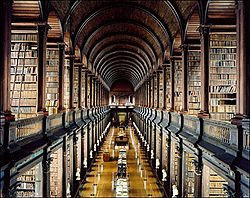Academic Library
From booktorrent

Contents |
Academic Library
An academic library is the library associated with a degree-granting institution of higher education. Academic libraries are identified by the post-secondary institution of which they are a part and provide all of the following:
- An organized collection of printed or other materials or a combination thereof;
- A staff trained to provide and interpret such materials as required to meet the informational, cultural, recreational, or educational needs of clientele;
- An established schedule in which services of the staff are available to clientele; and
- The physical facilities necessary to support such a collection, staff, and schedule[1].
Colonial Libraries
Until the American Revolution, most books were imported from England. When John Harvard donated approximately 300 or 400[2] of his books to Harvard University, he created the first academic library in the colonies. The colonial college libraries were characterized by small, eclectic collections of donated books. There was no funding from parent institutions to systematically purchase materials to supplement the colleges’ programs.
Libraries were vulnerable to fire because the buildings were made of wood. They were open for only a few hours per week and were operated by a professor who was assigned to be caretaker of the library as part of his teaching responsibilities[3].
Nineteenth Century
Changes in scholarship and learning during the late nineteenth and early twentieth centuries greatly affected libraries. The emphasis on publishing results of research during this period led to a proliferation of journals and scholarly monographs and the need for primary source materials.
Harvard and Yale were the first libraries to establish endowments during this period. This created a more stable financial base for those libraries.
College libraries during this period were not adequate for the students due to their limited hours of operation and limited collections. When Johns Hopkins University was established, faculty used the German seminar method for instruction instead of the recitation method. This created new demands for library services and materials. The librarians responded by keeping the library open longer, building stronger collections with primary and secondary sources, providing bibliographic instruction and reference service, and erecting multipurpose buildings designed to accommodate people as well as services[4].
Improved Use
At the end of the nineteenth century and into the twentieth, there was a definite shift in emphasis from conservation and protection of books to making them accessible and encouraging students and faculty to use them. There was recognition of the need to provide effective and personalized service as well as instruction in the use of the library and reference materials.
It became accepted that books should be classified according to subject and not according to fixed shelf locations. Each book was to be listed with an adequate bibliographic description and this information was to be made easily available to users by author and subject.
Cooperation with other libraries was seen as advantageous for borrowing materials. Hours were extended and facilities improved to provide a comfortable work environment for students from early morning to late evening on weekdays and for some hours on weekends. Financing the library became an accepted responsibility of the parent institution. Placing books on reserve for use by students in a particular course was a new practice. Book catalogs of materials held by individual institutions or by groups of libraries were published to facilitate the sharing of resources[5].
Twentieth Century
By World War I, most academic libraries had reference departments. Their purpose was instruction and guidance of the library user. The goal of reference work was to foster the independence of the user in locating research information. There was a trend toward specialization in reference service by subject (i.e., art librarian), type of material (i.e., rare books librarian; government documents librarian); and function (i.e., reference librarian or cataloging librarian).
Academic librarians have struggled with their professional role in colleges and universities. There has been ongoing debate about whether librarians should have faculty status and whether they can claim the same academic freedom rights as teaching faculty[6].
Twenty-first Century
Most academic libraries provide access to a more resources than ever before. However, the number of physical items in many libraries is declining, as libraries withdraw journal runs to which they have permanent online archival access and/or move lesser-used materials to off-site or shared storage facilities, thus freeing up areas that are repurposed to provide space for individual student and collaborative work. Libraries are expanding their virtual space, reducing space within the library facility for collections, and re-purposing it for student use. The concept of “Library as Place” is still important to students, researchers, and many faculty members. Some libraries have added writing, tutoring, and media centers to provide multiple academic support services in one convenient location[7].
Trends for Academic Libraries
- Academic library collection growth is driven by patron demand and will include new resource types.
- Budget challenges will continue and libraries will evolve as a result.
- Changes in higher education will require that librarians possess diverse skill sets.
- Demands for accountability and assessment will increase.
- Digitization of unique library collections will increase and require a larger share of resources.
- Explosive growth of mobile devices and applications will drive new services.
- Increased collaboration will expand the role of the library within the institution and beyond.
- Libraries will continue to lead efforts to develop scholarly communication and intellectual property services.
- Technology will continue to change services and required skills.
- The definition of the library will change as physical space is repurposed and virtual space expands[8].
References
- NCES Library Statistics Program
- History Magazine
- The History of Academic Libraries in the United States: a Review of the Literature
- 2010 Top Ten Trends in Academic Libraries
